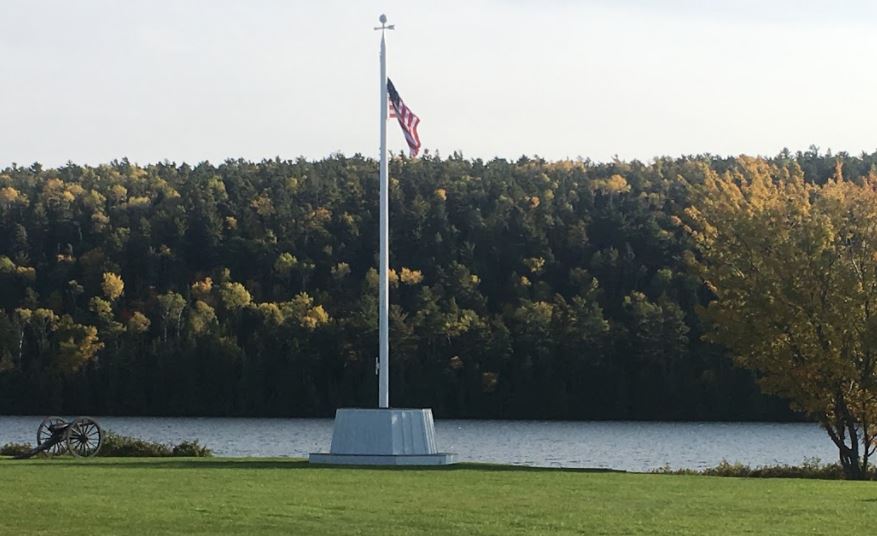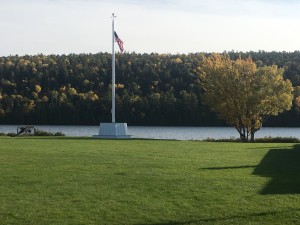
The once remote Copper Harbor is now home to a cozy town, with an old military post. Fort Wilkins, situated on the north shore of Lake Fanny Hooe and a couple miles south of Lake Superior, has kept a watchful eye over the Keweenaw, silently monitoring its progress since 1844. From the fur trade dominating the back country, to the full-fledged copper mining industry, Fort Wilkins has maintained civil authority in the region for over 170 years. [2, p. 2] [6, p. 1] With the rush of people north in the early 1840’s, hopes of new riches and adventures opened the Lake Superior frontier, setting the stage in the copper rich harbor for prosperity and military development.
Early Settlement
In 1842, the only thing keeping west settlers from packing north to the copper hills of the Keweenaw, was the uncultivated wilderness between them and the northern most tip of Michigan. With a treaty made in 1843 leasing land out from the Native Americans (which allowed the government to remove them from the peninsula when necessary), an established military post with two companies and a field officer, was recommended to maintain the concord in the harbor. [2, p. 3] As the new frontier miners accumulated in the harsh land, the government worried that the law and peace of the treaty and new land would not be upheld between the Native Americans and the unfamiliar settlers. The best solution was deemed to be militarizing the northern tip of the peninsula, as fast as possible.
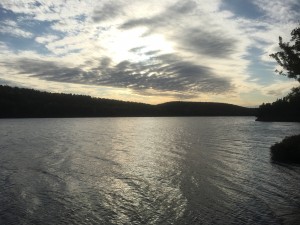
The fort was to be positioned so as to adequately aid the miners, and to move the Native Americans from the reservation when the time came. With directions to find a settlement anywhere in or near the copper region, that contained a good harbor for lake craft and was close to the normal tracks of navigation on Lake Superior, General Winfield Scott (the Secretary of War in 1844) authorized the search of the northern peninsula to begin. [2, p. 4] Sending Brigadier General Hugh Brady to survey the area, two sites were proposed to General Scott: L’ance (which was 60 miles south and east of Copper Harbor, and 30-40 miles from any other major cities in the copper region) or LaPoint (which was closer, but 12 miles outside of the copper region originally specified). [2, p. 4] Deciding the location based on the most suitable military position, LaPoint was approved, and the workings to start Fort Wilkins were set in motion.
Traveling by boat from Detroit, the 5th regiment (Companies A and B, a mere 105 officers and soldiers) arrived in Copper Harbor on May 27, 1844, with construction beginning immediately the next day [6, p. 1]. With the necessary natural resources to construct the fort’s barracks, bakery, and other buildings (many of which are still standing today), easily located around the base, the company was off to a good start. As time passed, the regiment was eventually subjected to aiding the civil authorities as a “posse comiatius”, or a body of people called upon by the sheriff to maintain peace. [10, p. 1] The soldiers were mainly utilized to ensure that the new life in the Keweenaw, along with the miners’ ability to search and mine for copper, was not impeded. [2, p. 7] With just a few more details left to completely finish the buildings, the company enjoyed warm quarters for their first winter. Although transportation to the remote location was difficult, the abundance of food from hunting and fishing around the base (and just enough vegetables to keep scurvy at bay), proved to allow the company a pleasant winter. [2, p. 8] [6, p. 1] By 1845, war had been declared with Mexico, and Brigadier General Brady prepared to move half of the 5th Infantry out, towards the Mississippi. [2, p. 9] However, in the midst of the chaos, the first Fourth of July celebration at the post was still underway.
Life and Growth
With Native Americans arriving by boat at dawn’s first light, and games alongside plenty of food to go around, the first Fourth of July celebration was one to remember. One such memory were the possible origins of Uncle Sam; a lean Yankee, Erastus Powell, (who was said to be a good story-teller who could hold his own against any odds), proposed that he represent the idea of the “father of the country”. Arriving by boat, clad in dress and make-up similar to the modern conception of Uncle Sam, Powell came ashore to meet Columbus and the Native Americans, reenacting the first settlement. Walking from the dock to the Fort, accompanied by drum and fife, Uncle Sam joined the party, and the festivities and feast continued.[2, p. 12]
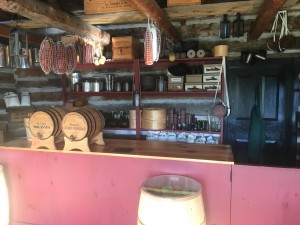
With things going so well in the Copper Country, the population began to rise. Little trouble, other than minor issues with miner’s leases regarding their stipulations, occurred in the Keweenaw, and the necessity of Fort Wilkins began to wane. The need for more men to fight the Mexican War forced General Brady to move the other half of his men out. Facing a decision on who would keep a watchful eye on the fort while he was absent, General Brady wrote the government to attain a proper caretaker. Proposing Dunning R. McNair, the Assistant Mineral Agent, to run the fort if no officer could be procured by the time he left, General Brady’s suggestion was denied, and Sergeant William B. Wright was placed in control alongside his wife. [2, p. 13] Beloved by all, Wright took a compassion into caring for the post; with such immaculate care, it was said that the quarters could be occupied again at a day’s notice. At the rise of the Civil War, however, Wright was called to action in 1861, where he was later wounded in 1864, during the Siege of Petersburg in Virginia. [2, p. 15] In the meantime, the post was rented out to Dr. Livermore, who utilized it as an open health resort, sending summer tourists and families to come and enjoy the lake air, for as little as a dollar a day [1, p. 2] [5, p. 4](equivalent to about $47 in 2017 [3, p. 1]).
As the necessity for copper continuously increased around Lake Superior, the argument for the development of a road to reach Fort Wilkins, was strongly encouraged. Not only would this open land communication—a vital commodity as communication was near non-existent in the winter months due to frozen harbors and deep snow—but it would also open a way for easier transport of materials, supplies, and mail. [2, p. 17] After debating different connecting points, routes, and the pricing for mileage, Green Bay was found to be the most practical route to take (over connecting Fort Wilkins to other settlements, such as the Straights of Mackinac). The steep price tag of $44,ooo (equivalent to approximately $1.3 million today [3, p. 1]) was agreed upon to cover the 250 miles from Fort Wilkins to Green Bay, with passable road. [2, p. 19]
From Land to Water
With the increased land travel, maritime navigation was also in need of an update. After the sinking of the Jon Jacob Astor (a schooner which was considered to be one of the original commercial vessels to sail Lake Superior) a cold reminder of the dangers of the rough waters and rocky edges of the lake was presented to the settlers. [6, p. 1] [7, p. 2] As the maritime industry increased with shipments of essential supplies and copper in and out of the harbor, the government was asked for assistance in way of navigation for the ships. The need for a lighthouse was ever present, with navigation into the harbor difficult even on the clearest day–but, with the land necessary to build the light signals still under the control of the War Department, a release of the lands was necessary before construction could begin. Once the land release was approved in 1865, Stephen Pleasonton constructed the Copper Harbor Light, situated at the entrance of the harbor. [6, p. 1] [9, p. 2] Once completed, the lighthouse allowed for safe travel in and out of the harbor, improving its light range capabilities as light technology advanced. [11, p. 3]
With safer travel, the shipping of copper out of the harbor and supplies back in, pioneers had access to many more commodities–tools, clothing, and extra food, could be found at Charley Brush’s sutler store, which was open to the public and families of Fort Wilkins. As the sutler store thrived, the economy in the remote Upper Peninsula grew, soon becoming a venue for a military experiment.
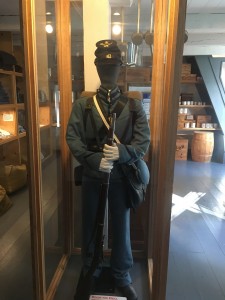
As a brawl broke out of the barracks one cold evening, an illegal, secret liquor supply was located and destroyed. Permission to gain greater control over spirits in the region was requested by the commander, in addition to the solidification of the stipulations and authority a commanding officer could have over the discipline of his soldiers. However, some couldn’t help but wonder if the use of spirits would help boost morale, instead of creating disrespectful soldiers as many originally thought. The Army decided to run a 3-month trial to determine the effects of selling alcohol to soldiers, with the commanders at various posts reporting back after experiment. [2, p. 21] Though there were no significant changes in morale, there was also no significant declines in behavior. The commander of Fort Wilkins wrote back, advising the government that although it would not be a large concern, the lesser of the two evils should be chosen. Finding the spirits to be the less evil, the Army approved the sale of alcohol, under strict regulations.[2, p. 22]
Coming to an End
At the close of the Civil War, the military found itself overpopulated with officers. With the majority of these men needed in parts of the South and along the Mississippi, rumors of a Native American raid from the North sent men up to the all but abandoned Fort Wilkins, to contain the troubles and maintain order.
In 1867, Fort Wilkins was inhabited once more. Company E, the 45th Infantry, would travel with 54 men from Fort Wayne and settle in at the Keweenaw on September 25, under the command of Captain Kenelin Robins [2, p. 27] [5, p.3]. With the average yearly snowfall of 176 inches for the past thirty years, it’s no surprise that the winter came as a shock to Captain Robins’ men—some had never learned to skate, let alone experienced more than 6 inches of snow at a time. [2, p. 27] [4, p. 15] Coming late that year, the snow didn’t stop accumulating until the land was covered with about four feet by Washington’s birthday. Despite the setbacks of an intense winter, and a large learning curve for the soldiers in dealing with the copious amounts of snow, the winter passed with an abundance of fuel, good food, and little sickness.
![Average Snowfall in the Upper Peninsula 1931-1960 [4, p. 17]](http://ss.sites.mtu.edu/mhugl/wp-content/uploads/2017/10/avg_snowfall_UP-300x211.jpg)
Looking for ways to reduce costs without harming the military’s operational strength, the government needed to determine the benefits/consequences of closing Fort Wilkins. Deciding to discontinue the base, the last occupying Company K, U.S. Infantry, was sent to Fort Wayne in 1870. [2, p. 37] [5, p. 3] [8, p. 1] With everyone moved out, Sergeant Slaven inherited the responsibilities of the fort, ensuring that the land and buildings were properly preserved and well maintained. The Secretary of War decided in 1870 to sell the base, determining it no longer useful for military service. [2, p. 40] [6, p. 1 ] [8, p. 1]
With the decay of the buildings, the property passed through from the Secretary of War to the Lighthouse Board, on to Houghton and Keweenaw counties, in an attempt to preserve and restore the post in 1921. [2, p, 43] [6, p. 1] Fort Wilkins finally laid to rest in the hands of the state, standing as one of the few forts left with its original buildings still intact. Now a national park, the fort can be used as a leisurely summer recreational area, and a venue to step back in time and experience what life was like on the frontier. [2, p. 48] [6, p. 1] [11, p. 13]
Without the construction of Fort Wilkins, and the establishment of new settlers in the mid-1800’s, the great North would never have had the success it saw. With its booming shipping trade through the waters of Lake Superior, to its bountiful copper mines and plentiful resources around the lands, Fort Wilkins saw the development of the frontier into what it is today. It is thanks to the hard work of the men and women at Fort Wilkins, who fought every day to not only develop the frontier, but also to make it through bitterly cold winters and endure the harsh waters to sail there, that Copper Harbor saw over 125 years of successful copper mining and shipping through Lake Superior, effectively opening the frontier for anyone who had an eye for adventure.
Primary Sources
- “Portage Lake News: Accommodate Tourist at Copper Harbor”. The Copper Country Evening News, 22 Oct. 1907, p. 2,3.
- Emery, B F. Fort Wilkins: 1844-46. Detroit, The Old Forts and Historic Memorial Association, 1932, pp. 1-51.
- “Inflation Rate between 1844-2017 | Inflation Calculator.” Dollars in 1844 → 2017 | Inflation Calculator, 2017
- Michigan Snow Depths. “Mean Snowfall 1931 – 1960.” Chart. Michigan Weather Service; Michigan Department of Agriculture, 1974, pp. 2-17.
- Michigan Tech Archives: “Data Copied from walls of out-house at Ft. Wilkins.” Fort Wilkins, 14 Sept. 1871.
Secondary Sources
- “The Fort Wilkins Story“. Michigan Department of Natural Resources, 2012.
- “September 21, 1844: The schooner Jon Jacob Astor sinks off Copper Harbor” Zenith City Online, 25 Aug. 2017.
- “The Fort Wilkins Story.” Fort Wilkins Natural History Association- History, 2015.
- Seeing The Light – Copper Harbor Lighthouse.” Copper Harbor Light, 8 Sept. 2005.
- posse comitatus. Dictionary.com. 2017.
- Pomber, E. T. (2016). Archaeological Investigations And Historical Survey, Fort WIlkins Historic State Park: Keweenaw County, Michigan. Open Access Master’s Report, Michigan Technological University, 12-13.
Further Reading
- Fort Wilkins: Insignificant Military Post (2015, April 10). In The Daily Mining Gazette.
- Michigan Tech Archives: “Letter from Mrs. Charlotte Farwell to Mrs. Sallie Scott, pertaining to Ft. Wilkins, Copper Harbor.” Spokane, Feb. 1915.
- Michigan Tech Archives: “Detailed History of Old Fort Wilkins is Furnished by Townsend.” Michigan.

